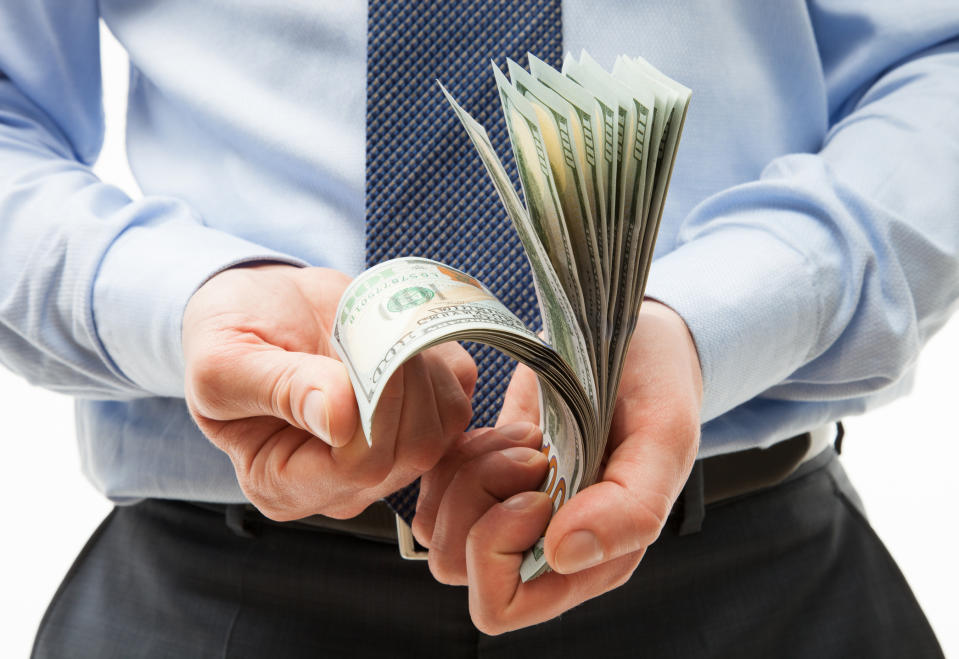The 3 Most Dangerous Ultra-High-Yield Dividend Stocks
Generally speaking, dividend stocks are what make the most successful portfolios tick. Aside from the fact that dividend-paying stocks have historically outperformed their nondividend-paying peers, companies that share a percentage of their profits with their shareholders offer a host of other advantages.
For example, dividend-paying stocks are often beacons of profitability and represent time-tested business models. A management team or board of directors is unlikely to share a percentage of profits with shareholders if they didn't believe that growth and/or profitability will continue. And, usually, consistently profitable companies tend to do well over the long term.

Image source: Getty Images.
Dividend payouts can also help hedge against inevitable downside in the stock market, and be reinvested back into more shares of dividend-paying stock via a dividend reinvestment plan (DRIP). DRIPs are a really common strategy employed by money managers to build wealth over the long run for their clients.
The stock market's most dangerous ultra-high-yield income stocks
Yet, dividend stocks also have a bit of a dark side. Namely, yield and risk tend to be correlated to some extent. This is to say that high-yield (4%-plus) and ultra-high-yield (10%-plus) dividend stocks may lag in the return department when stacked up next to companies paying out say 2% a year. Remember, since yield is simply a function of share price, a flailing business model with a declining share price can lure in unwitting investors with a high yield.
The good news is that there are a handful of ultra-high-yield stocks that very well may be worth buying. Unfortunately, there are a veritable sea of questionable ultra-high-yield income stocks. The following three look to be the most dangerous, with the highest probability of a substantial cut to their payouts, in my opinion.

Image source: Getty Images.
GameStop: 15.1% yield
Over the past couple of years, it's been anything but "game on" for video game and accessories retailer GameStop (NYSE: GME). Once a dominant force in the console industry, GameStop's business model has been completely upended by the emergence of digital downloads from the cloud. In other words, the need to go to a gaming store for new games or accessories is dwindling... fast.
In GameStop's all-important fourth-quarter, the company announced a 7.6% drop in global sales, with new hardware sales declining just shy of 10% and pre-owned sales tumbling 21.3%. The latter of which is a serious problem, because pre-owned sales are the company's highest-margin line item. So, just to put this in another context, not only is GameStop's business model completely at risk, but the highest-margin portion of its model is what's drying up the fastest.
To be clear, the company is focusing on digital downloads, with digital receipts up almost 5% in the fourth quarter. The problem is that this accounted for just 14% gross sales, so it's not hedging much of the weakness the company is facing. This has led GameStop to pretty much focus on debt reduction and cost-cutting in 2019.
Furthermore, GameStop expects total sales and comparable-store sales to decrease by 5% to 10% this year, with no particular timeline as to when things will get better. With the company currently paying out $1.52 in annual dividends, Wall Street's consensus projects that profit could dip well below $2 this year and continue heading lower thereafter, especially with Alphabet now aiming to reshape the gaming space by introducing a streaming service known as Stadia. Things do not look good at all for GameStop or its dividend.

Image source: Getty Images.
BP Prudhoe Bay Royalty Trust: 18.4% yield
Easily one of the highest-yielding stocks on the planet, BP Prudhoe Bay Royalty Trust (NYSE: BPT) and its more than 18% yield may very well be the most dangerous dividend stock of them all.
The business model here is really quite simple. BP Prudhoe Bay is a trust that owns a royalty interest in the oil that BP produces in the Prudhoe Bay in Alaska. In general, the higher oil prices head, the more robust the royalty is that the trust receives, up to a certain number of barrels. After paying for the normal operating expenses of the trust, the remaining profit is then returned to investors in the form of a big dividend. This simple model has produced some huge yields in the past.
However, there's a problem, and it really doesn't have anything to do with oil prices. Rather, there's a finite limit on how much oil can be produced in Prudhoe Bay. Once production dips below feasible levels to operate the trust, it'll simply liquidate, with no further dividends paid. Once that happens, the value of an investment in this trust could plunge substantially.
So, the big question is, when does the trust foresee production no longer being feasible? According to BP Prudhoe Bay's 2017 annual report, dividends may cease after 2019, with the 2018 annual report updating that figure to 2022. Regardless of which estimate proves more accurate, this dividend cessation projection changes often, and the fact remains that little time is left for investors to collect a dividend and recoup their investment. Barring an incredible surge in the price of West Texas Intermediate, this is a dangerous double-digit-yielding dividend stock.

Image source: Getty Images.
Barnes & Noble: 10.7% yield
Not to pick on the retail industry, but the third and final ultra-high-yield stock that income investors would be wise to avoid is the nation's largest bookstore chain Barnes & Noble (NYSE: BKS).
Once a force to be reckoned with, Barnes & Noble is merely a shell of its former self. Following a holiday season where the company beefed up advertising and marketing, and the U.S. economy hummed along with its strongest GDP growth and lowest unemployment rate in a long time, Barnes & Noble managed to grow comparable store sales by... just 1.1%. Mind you, this was its best performance in years, albeit sales remained flat.
The big problem for Barnes & Noble is that it's a physical retailer that's incapable of taking on Amazon.com (NASDAQ: AMZN). Even with an e-commerce presence, Barnes & Noble lost the vast majority of its core customers to Amazon a long time ago. Plus, it doesn't exactly have the bells and whistles Amazon can offer via Prime (i.e., 2-day shipping and exclusive streaming content, to name a few benefits), so it's left to rely on razor-thin margins in order to lure in its previous core customer.
Currently paying out $0.60 a year, Barnes and Noble isn't projected to get anywhere near this level in adjusted earnings per share in 2019 or 2020. In fact, the company has paid out $0.45 per share in dividends on $0.31 per share in adjusted EPS through the first 39 weeks of fiscal 2019, with a generally weak quarter up next (translation: losses are likely).
Cost-cutting and its lofty dividend have kept Barnes & Noble afloat within the investment community for years, but with next to no catalysts and an expected slow decline in sales, there doesn't appear to be much hope for its dividend.
More From The Motley Fool
John Mackey, CEO of Whole Foods Market, an Amazon subsidiary, is a member of The Motley Fool's board of directors. Suzanne Frey, an executive at Alphabet, is a member of The Motley Fool's board of directors. Sean Williams has no position in any of the stocks mentioned. The Motley Fool owns shares of and recommends Alphabet (A shares), Alphabet (C shares), and Amazon. The Motley Fool owns shares of GameStop and has the following options: short April 2019 $13 calls on GameStop. The Motley Fool has a disclosure policy.

 Yahoo Finance
Yahoo Finance 